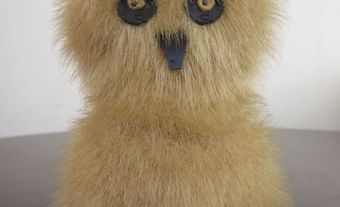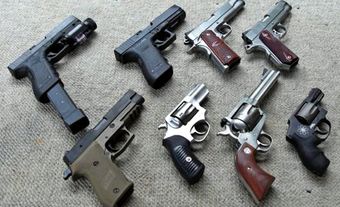Rugs and Rug Making
A hooked rug is made by pulling loops of yarn or rag strips up through a loosely woven foundation cloth, usually burlap, using a tool like a crochet hook. Eventually, these loops of different kinds of material in a variety of colours create a design - pictorial, floral or geometric - which covers the whole foundation and forms a sturdy mat.
In the mid-19th century when hooked rugs were first made, floor covering was a luxury in Canada. The wealthy might have an imported oriental rug or perhaps could afford commercial loom-woven carpeting. Others might make (or have made) a catalogne rug, consisting of a weft of rag strips woven on a widely spaced warp of cotton string. The hooked rug solved the problem of covering cold floors cheaply and was the final stage in the recycling of hand-me-down clothing.
Very little 19th-century everyday clothing is left in Canada: cloth was too precious to waste and much of it ended up in QUILTS or on the floor (see CLOTHING). It is probable that rug hooking developed independently and simultaneously in several centres: Québec, the Maritimes and New England. Hooked rugs were made in much greater numbers in the eastern half of the continent than in the western half since, by the time the Canadian West was settled, store-bought floor coverings had become available.
The most immediately recognizable of Canadian rugs are those from the Grenfell missions in Newfoundland and Labrador. Grenfell rugs have been made since 1913 when Dr Wilfred GRENFELL industrialized the local mat-making activities. Standard patterns (eg, dogsleds, flights of geese, polar bears) were reproduced on burlap, and then the rugs were hooked by local women. The rugs were sold widely through churches to raise money for medical missions.
Grenfell mats, which are still produced today using chemically dyed synthetic fabrics in place of the original natural fibres and vegetable dyes, have always been extremely finely hooked and look almost like needlepoint. Browns and greens predominate in the early rugs, which contained much burlap yarn, as well as underwear and stockings collected on the mainland and donated to the missions.
The fine workmanship of the rugs of Cheticamp, NS, is also legendary. The Cheticamp rug industry was established by Lillian Burke at the instigation of Mrs Alexander Graham Bell, who was impressed with the possibility of establishing a homecraft industry in Cape Breton.
Unlike quilts, which are often treasured within a family and passed from one generation to the next, old hooked rugs are usually orphans whose family history has been lost. It is rare to find a very old rug whose maker is known. However, one famous rug hooker was Emily CARR, who made rugs to supplement the income she earned from her boarding house.
Many rugs designed by the artist Georges-Édouard Tremblay can be identified. As part of the Québec CRAFT revival, these rugs were copied in his Pointe-au-Pic studio (now La Malbaie-Pointe-au-Pic) from Tremblay's landscape paintings by local women working under his direction; the rugs were often hooked from heavy cotton yarn and featured a wide black edging around a snow scene.
In 1868 Edwards Sands Frost, a Maine tin peddler, devised a series of zinc cutouts that allowed him to mass-produce stencilled patterns on burlap for rug hooking (an early version of paint by number). Other companies also entered the market. By the mid-1890s Garrett's of New Glasgow, NS, was producing Bluenose rug patterns. In 1894 Wells and Richardson of Montréal published patterns in its Diamond Dye Rug Books ("Do not sell your rags to the travelling rag-gatherer; save them and work them up into handsome and useful Rugs and Mats").
By 1905 Eaton's was advertising Monarch hooked rug patterns in its catalogue, and in the early years of the century Hambly and Wilson of Toronto also produced patterns on burlap.
Pattern rugs are still made today, but the most impressive rugs have always been those devised by women from their own materials and visions. Many old Canadian hooked rugs are surprisingly eloquent. They speak of economy, individuality and utility. Women incorporated into these rugs generations of clothing and memory-laden cloth - the very fabric of their lives.

 Share on Facebook
Share on Facebook Share on X
Share on X Share by Email
Share by Email Share on Google Classroom
Share on Google Classroom


